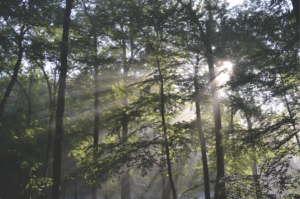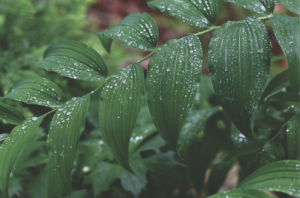Nature Mindfulness Walk
Photos by Chris Swisher and Stephanie Kuniholm, courtesy of Jenkins Arboretum & GardensUse the following prompts to help slow down and observe nature in your backyard or neighborhood
Since march 2020, we’ve all learned new ways to deal with stress, manage anxiety and cope with unwelcome change. For many, the restorative benefits of spending time in nature have been the balm to ease the damages of this past year.
Getting outside is more than just a change of scenery! Research shows that spending just two hours a week in nature is associated with good health and wellbeing.*
If you’re looking to add a new tool to your stress-management toolbox, why not take some time for a self-guided mindfulness walk?
How do you do that?
Use the following prompts to help slow down and observe nature in your backyard or neighborhood, even if it’s just from a window or balcony. We, of course, suggest a mindfulness walk in a lush garden, like Jenkins Arboretum & Gardens. The quiet, leafy trails winding through Jenkins’ Woodland Walk provide a perfect setting for a moment of mindfulness.
Give it a try. Or at least two hours.
*Among other articles supporting this conclusion is the 2019 article by Matthew P. White et al., “Spending at least 120 minutes a week in nature is associated with good health and wellbeing” published in Science Reports. Nature.com/articles/s41598-019-44097-3.
Sky
 Begin your walk by standing still and looking around you.
Begin your walk by standing still and looking around you.
Pause to look up at the sky. Then down at your feet and around to the plants growing nearby. Notice the noise of neighbors, critters or cars. Feel the ground underneath your feet, the breeze or sun on your face, and the sound of your own breath.
Reflect on the joy, strength and delight we find in nature. Make a decision to set aside your thoughts, worries, plans or regrets and focus on the living world in front of you.
Tree
 Continue walking until you find an old, sturdy tree to stand beside. Look for one of the many Chestnut Oak trees (Quercus montana) that make up the canopy at Jenkins Arboretum.
Continue walking until you find an old, sturdy tree to stand beside. Look for one of the many Chestnut Oak trees (Quercus montana) that make up the canopy at Jenkins Arboretum.
Pause to look up at the farthest reaches of the branches and down to the sturdy flare of the tree’s base. Think of the storms this tree has weathered, the depth of its roots, the birds and insects who live on and within its branches and leaves.
Reflect on your own strength and growth. What storms have you weathered over the years? What roots have you set in your community? How do you provide shelter and a sense of “home” to those around you?
Leaf
 Continue walking until you find a fallen leaf on the ground. Find a spot to sit or stand for a few moments while holding the leaf.
Continue walking until you find a fallen leaf on the ground. Find a spot to sit or stand for a few moments while holding the leaf.
Pause to look at the leaf in your hand. Feel the texture of the edges, look closely at the veins, spin the stem in your fingers. Think of the seasons of change for this leaf: swelling as a leaf bud in late winter, emerging as a bright new leaf in spring, spreading out and soaking the summer sun, changing color in the cool days of fall, then dropping to the ground in winter. Think of the repeated cycles of the seasons.
Reflect on the seasons and cycles in your own life. When have there been times of dormancy followed by seasons of growth and flourishing? During this early summer season, are there areas in your life that you find to be new, fresh or unfurling?
Soil
Continue walking until you find a place where you can kneel down and pinch a small amount of soil in your hand.
Pause to look closely at the color of the soil. Hold it near to your face and breathe in the fresh scent of the living earth. Feel the cool, moist soil in your hands. Think of the nourishment provided by the soil and the ways in which this small bit of earth contributes to the health of all plants and animals.
Reflect on the sources of nourishment in your own life. Whether it’s family, friends, music, nature, movement, books, pets, art, faith or even solitude—what are the things in your world that provide nourishment? Who or what provides the spiritual and emotional nutrients you need to live a healthy life?
Water
Continue walking until you see water. This could be a stream, creek, pond, puddle, droplet on a leaf or even the contents of your water bottle. At Jenkins Arboretum, walk down the hill to the pond or walk farther to the stream.
Pause to look at the water. Listen to its movement and watch its flowing motion. Think of all the places this water has been, and all the place it is going. Notice how the water never looks the same for more than a moment—it’s constantly changing shape and color.
Reflect on the movement and motion in your own life. What are the ways you continue to move forward and flow? How can you be present and aware in the middle of change?
Home
After returning home, spend a few minutes writing down or sketching your experiences. Take a moment to be grateful for the time you spent slowing down and breathing deeply. And take a moment to be thankful for the nourishment and life we receive from the Earth.
Photos by Chris Swisher and Stephanie Kuniholm, courtesy of Jenkins Arboretum & Gardens.
Jenkins Arboretum & Gardens is a 48-acre public garden showcasing native flora of the eastern United States and a world-class collection of rhododendrons and azaleas. The gardens are open every day of the year from 8 a.m. to sunset and admission is always free. 631 Berwyn Baptist Rd., Devon. 610-647-8870; JenkinsArboretum.org.
